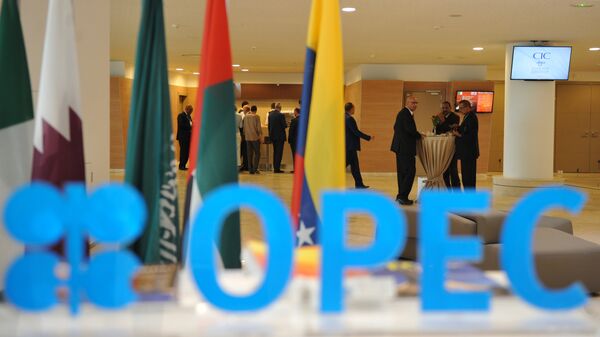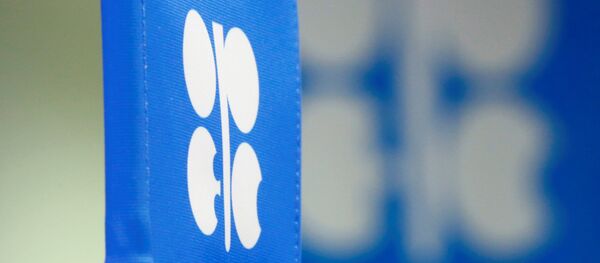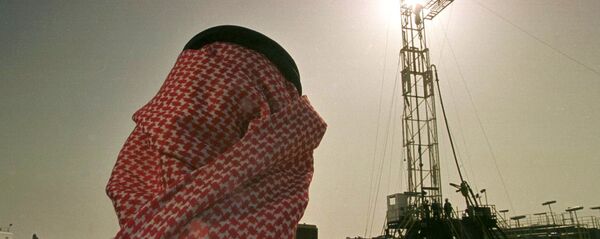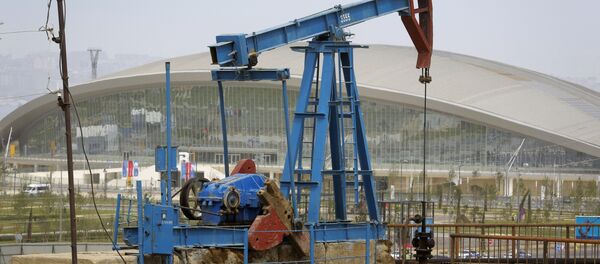Besides the whopping world oil glut of 300 million barrels, several other major factors affected the falling oil prices. Saudi Arabia refusing to cut oil production, Iran returning to the market after striking a nuclear deal with the P5+1 group of world powers in exchange for the removal of sanctions and the United States driving up its production of shale oil all contributed to the global oil price slump.
Doha failure
In mid-February, the energy ministers of Saudi Arabia, Qatar, Venezuela, and Russia discussed the current oil market situation in the Qatari capital and agreed to freeze oil production at January levels throughout 2016 if other countries followed suit, in a bid to keep the oil prices from falling further. While a number of other countries have expressed interest in the deal, Iran did not take part in the meeting.
News of the planned output freeze deal have been buoying oil prices since February, recovering prices to around $40 per barrel for the Brent crude benchmark, a level held steadily since early March. Brent surged further to $44 per barrel in April as Russian and Saudi Arabian representatives reportedly reached consensus on freezing oil output.
In mid-April, Qatar informed Russia that 17 countries including non-OPEC oil producers Azerbaijan, Mexico, Kazakhstan and Oman would be participating in another meeting in Doha dedicated to negotiating freezing the extraction of oil.
Iran, which previously voiced its intention to ramp up its daily production to 4 million barrels to regain its share of the world's oil market, declined taking part in the output freeze. Markets reacted badly to Tehran's final decision to abstain from the deal, with Brent dipping below $44 per barrel.
Moreover, a number of Gulf countries, including Saudi Arabia, the United Arab Emirates, Kuwait and Qatar, changed their position on the draft deal just before the meeting started, demanding more countries to be bound by its conditions.
In total, 18 countries participated in the Doha meeting with several major producers turning down the invitations to join the negotiations, such as Norway, Western Europe's largest oil producer. The conference's failure caused crude prices to drop by almost 7 percent to $38.66 a barrel.
No further efforts to align positions
Although OPEC and non-OPEC countries postponed making a decision on oil output cap until the cartel agrees on quotas during the 169th session in Vienna, no apparent efforts have been seen between rival Iran and Saudi Arabia to reach a consensus on the matter.
Moreover, oil prices have risen to around $50 per barrel ahead of the meeting, partially caused by temporary factors such as the wildfires in Canada and output disruptions in Nigeria, raising concerns over the possibility of another price downfall.
Although Iranian delegation led by Petroleum Minister Bijan Zangeneh agreed to take part in the June 2 OPEC meeting, Tehran reiterated its intention not to take part in the cartel’s possible oil production freeze. Instead, Iran pledged to bring its market share and production level to the pre-sanctions levels.
Meanwhile, the Ecuadorian delegation, headed by Oil Minister Jose Icaza, canceled a trip to Vienna to take part in the OPEC ministerial meeting due to an earthquake in Ecuador, further undermining the cartel’s efforts to curb the oil production.
Hours before the meeting, Nigeria and Venezuela announced they would on the contrary increase the oil output to 2.2 million and 3 million barrels per day respectively throughout the year.
Following his appointment, Barkindo stated that the cartel’s ministers intend to strengthen relations with non-OPEC and particularly Russia.
Despite OPEC’s lack of decision to limit production amid a global oil oversupply, prices rose 0.3 percent following the 169th session after the US data revealed continuing decrease in US crude oil production and inventories by 1.4 million barrels in the week ended May 27.
The conference also decided to hold the next meeting of the organization on November 30.
Algiers Accord
In early August, current OPEC President Mohammed Bin Saleh Al-Sada said that the cartel's member states were planning to hold informal consultations on the sidelines of the 15th International Energy Forum (IEF), scheduled for 26-28 September in Algiers.
As efforts to stabilize the oil market have been reenergized, Russia and Saudi Arabia announced the meeting of their first working group on oil and gas cooperation meeting in October, as well as consultations on the sidelines of the IEF in Algiers.
Closer to the meeting, ministers of major oil producers have changed their stance on the possibility of reaching a global oil output cut deal to positive, with Russian Energy Minister Alexander Novak stating he had received a proposal on oil production cap from Venezuela and Algerian Energy Minister Noureddine Bouterfa revealing the negotiations could be secured by two agreements, one within the cartel and the other between the OPEC and non-cartel producers.
Even Libya, which has insisted on concessions due to the ongoing civil war in the country, said the country could consider oil output freeze when the national oil output level reaches OPEC quota.
Nevertheless, all 14 ministers of OPEC showed up for the IEF opening session including Iran’s Minister of Petroleum Bijan Namdar Zangeneh and Saudi Arabia's Minister of Energy, Industry and Mineral Resources Khalid Al-Falih, signaling that oil producers were finally ready to sign an oil output freeze deal.
Confirming this notion, Algerian Energy Minister Noureddine Bouterfa said the meeting in Algiers, which was being dubbed informal, could be transformed into an extraordinary official session depending on the progress of discussion.
Although Russia’s Novak traveled to Algiers for bilateral consultations with Barkindo and energy ministers from Venezuela, Saudi Arabia and Qatar, he was undecided on attending OPEC talks on September 28.
During the course of three-day consultations on the IEF sidelines, the cartel made a decision to hold an informal meeting without the participation of non-OPEC countries, according to Venezuelan Oil Minister Eulogio del Pino.
Prior to his departure from Algiers ahead of the informal OPEC talks, Novak revealed that the cartel was considering concessions for Iran, Nigeria and Libya and that the formal decision on oil output freeze would be taken in November during the cartel’s next official session.
On September 28, after almost six hours of consultations, the cartel surprised the international community by overcoming their differences and agreeing on not freezing but cutting oil production by introducing an oil output ceiling in the range of 32.5-33 million barrels per day during the session that had been turned into the 170th extraordinary OPEC meeting.
The preliminary agreement, later dubbed the Algiers Accord, outlined the establishment of a special technical committee tasked with distributing quotas between individual OPEC countries and presenting results of the research at the next meeting of the cartel in Vienna on November 30, when OPEC agreed to finalize the deal.
During the press conference after the OPEC talks, Qatari Energy and Industry Minister Mohammed Saleh Abdulla Al Sada confirmed Iran, Libya and Nigeria would be "treated specially" and presented with flexible conditions on oil output figures.
Following the meeting, Russia hailed the oil output cut agreement, which caused crude prices to climb more than 6 percent to $48.85 a barrel, and once again reiterated its readiness to take part in joint actions of OPEC and non-OPEC states.
Historic agrement between OPEC, non-OPEC countries
Ahead of the scheduled 171th OPEC session in Vienna, the OPEC secretary general visited all member countries of the cartel to make sure the oil producers would abide by the oil output cap and finalize the deal during the next meeting.
Furthermore, the ministers of the oil producing countries met informally on the sidelines of the Gas Exporting Countries Forum (GECF) in Doha on November 18, reaffirming their commitment to the Algiers Accord to cut production to 32.5 million barrels per day.
Other non-OPEC oil producing states also expressed their interest in joining the cartel to freeze their oil output, including Azerbaijan and Kazakhstan. However, they were not expected to attend the OPEC ministerial meeting, as the cartel’s oil producers had to finalize their agreement first.
Finally, on November 30, OPEC agreed to impose an oil production ceiling totaling 32.5 million barrels per day, expecting Russia and other non-cartel states to contribute to the deal by reducing 600,000 barrels per day collectively. The deal is set to be effective for six months and extendable for another six months depending on oil market conditions and forecasts.
The OPEC deal also upheld concessions for Iran, Libya and Nigeria, which were previously promised in the Algiers Accord. While Libya and Nigeria are now free not to cut their oil production, Iran can also boost its production by 90,000 barrels per day.
Although Iraq previously expressed unwillingness to reduce its oil production from maximum of 4.7 million barrels daily, the country still joined the OPEC deal promising to reduce oil production by 210,000 barrels per day to 4.351 million barrels per day.
Meanwhile, Indonesia, which reactivated its OPEC membership in late 2015, decided to suspend its membership yet again during the much-anticipated talks in Vienna, being unable to impose needed cuts.
Media reports suggested that the OPEC deal on cutting oil production was facilitated by a phone conversation between Saudi Arabia’s Al-Falih and his Russian counterpart Alexander Novak that broke the impasse a day before the cartel's meeting in Vienna. Russia allegedly agreed to not only freeze but cut its production in return for Al-Falih forcing the cartel to submit hard numbers for the organization’s output curbs.
On December 10, Vienna hosted the last round of OPEC talks this year, as the cartel invited 14 non-OPEC members to a meeting in a follow-up to its deal to set an oil production ceiling at 32.5 million barrels a day to raise the prices.
While Russia would cut its production by 300,000 barrels a day, Mexico, Azerbaijan and Kazakhstan would reduce oil output by 100,000, 35,000 and 20,000 barrels per day respectively.
The major oil producers also agreed that Russia and Kuwait would head a committee overseeing the implementation of the oil output cut agreement between OPEC and other oil producing states participating in the deal, which could later be extended for another six months. The special committee is expected to report its findings to the 172nd OPEC conference, which will be held in Vienna on May 25, 2017.
$55-60 per barrel ‘absolutely comfortable’ pricing for oil producers
While the November 30 meeting caused the price of oil to increase by 9 percent, or over $4 per barrel, the historic December 10 meeting surged oil prices by over 5 percent to $56.7 per barrel, their highest level since July 2015.
"Crude futures prices moved sharply higher in the first weeks of December, following OPEC and non-OPEC meetings," the cartel confirmed in its December report.
OPEC member states, including Kuwait and Venezuela, predict the average oil price per barrel to be around $50-60 in the coming months, which would be "a good price", compared with this year’s average of $34 dollars per barrel.
"The price which is being now formed at the level of $55-60 per barrel is absolutely comfortable for all oil producers. It allows balancing the interests of both producers and consumers of oil," Alexander Novak said following the December 10 meeting in Vienna.
However, Russia’s oil giant LUKoil predicts oil prices to recover to $80 per barrel by 2030 if all world oil producers agree to participate in leveling out imbalance of demand and supply. The Vienna Agreement on oil production curtailment was designed exactly for that purpose.
"Long-term oil price in the agreement scenario stands at $80 per barrel in constant prices. In our opinion, this price enables steady development of the oil market and effective use of energy resources," LUKoil said in its forecast for the oil market until 2030.
As of now, the global oil inventories still have over 300 million barrels in excess and the oil glut needs to decrease "at least to its average level in the past 5 years" for the market to recover, which may happen in the second half of 2017, according to Novak.
The cartel stands by the more optimistic stance, stating that "investments are expected to come back to this industry at a faster rate" already in the beginning of 2017, Barkindo said.
Mirroring this notion, the Iraqi Oil Ministry expects oil prices to stabilize in the first half of 2017 and fluctuate on the level of $60-$70 per barrel if OPEC and 11 non-cartel states abide by the oil output cut agreement.









